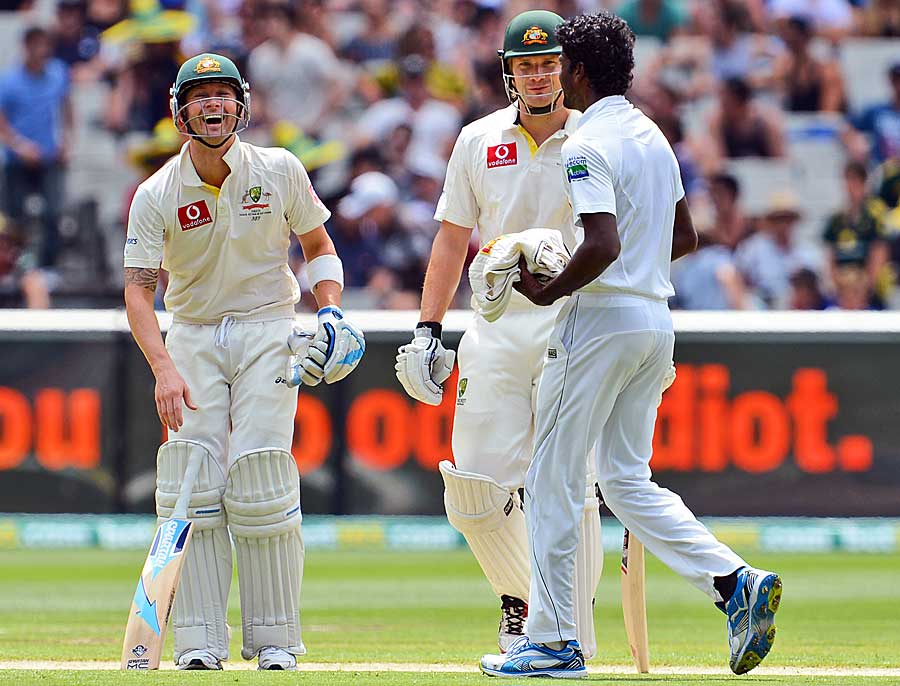Pranay Sanklecha in Cricinfo

The bouncer: not worth the risk © Getty Images
Enlarge
The death of Phillip Hughes was also the death of a certain kind of false, if sincere, innocence about the game. We are reminded that cricket balls can kill. So what should we do about bouncers?
The standard answer - unanimous, even, when it comes to the old pros who constitute the majority of those who write and talk about cricket, is: nothing. There is nothing to do. Keep calm and carry on. We must understand that what happened to Hughes was a tragic but freak accident (by the way, as Andy Bull wrote in the Guardian, such tragedies happen more often than we might unthinkingly assume). Be sad because it's a tragedy, but don't let it change anything because it was a freakish one.
Let one view stand for the rest. This is what Mark Richardson had to say:
Don't get me wrong. I don't want to see people getting seriously hurt and what happened to Phillip Hughes is just awful but what people have to accept is that this was such a freak occurrence and serious injury is still so rare that it does not in any way suggest cricket has a problem with the short ball at all. In fact, if cricket took away the bouncer, then we would have a problem. So let's mourn the loss of Phillip Hughes but not use it to grandstand unnecessarily.
I agree. Let's not grandstand unnecessarily. But let's also realise that this is a difficult question, and to dismiss the view that bouncers ought to be banned is itself unnecessary grandstanding, just from the opposite direction.
Let's first realise that there is a moral question here. When you run in and bowl a bouncer, you are (often, not always) aiming it at the batsman. If you're even halfway quick, you know - or after the death of Hughes you ought to, anyway - that you're doing something that carries a risk of causing death, a much greater risk than most other actions carried out while playing cricket.
It doesn't follow that you ought not to do it, or that you are to blame for doing it. What does follow is that you need a valid justification for doing it, and this is not provided by the trope that the bowler doesn't intend to hurt the batsman. Good for the bowler, but it still doesn't address the question of whether he's morally justified in imposing the risk of a very great harm on the batsman.
Now imposing a risk of a very great harm is not the same as imposing a great risk of harm. For instance, each time you fly, you run a tiny risk of a very great harm, while if you gently lob a pebble at someone from a few metres away, you impose a very big risk of a very small harm.
We seem comfortable with the former. Driving, for example, kills hundreds of thousands of people every year, but we do not believe that it should be banned. Why not? Because of roughly these two reasons: first, we believe that the benefits of the practice of driving outweigh the harm of the tragedies it causes; second, we believe that the risk of causing those harms is to some extent unavoidable. We try to minimise those risks, but we accept that given current technology we cannot eliminate them, and we accept them because of the value to us of being able to drive.
And this has been roughly the argument when it comes to bouncers. People outline its benefits: it's thrilling (which Test cricket needs to stay alive), it maintains the balance between bat and ball, it's a test of courage and thereby reveals character (men from boys and all that), it is part of the tradition of the game.
We can accept all of that, for the sake of the argument. But even after we do, we haven't justified the use of bouncers because there is one crucial difference between the practices of driving and of bowling bouncers.
For the justification of driving, it's crucial that its benefits can't be realised without running the accompanying risks. If they could, there would be absolutely no justification left for running those risks.
The bouncer does indeed create benefits. But it does not seem indispensable to creating them. Tradition is not justification, and even if it were, our traditions are mostly the innovations of an earlier time. Eliminating the bouncer would end a tradition, but it would simply be part of the story of the evolution of cricket, and many other traditions would remain. And if you want thrilling Test cricket and a competitive balance between bat and ball, you can achieve both by the simple expedient of making pitches better.
Eliminating the bouncer would end a tradition, but it would simply be part of the story of the evolution of cricket, and many other traditions would remain
One way of doing this would be, of course, to make pitches bouncier, which would increase the risk of inflicting harm, and this might seem to contradict my argument. To quote Mill, via Kipling, "nay, nay, not so, but far otherwise". First, leaving grass on, and allowing pitches to take spin, both make pitches more competitive without necessarily imparting greater bounce. Second, a bouncy pitch would certainly make it more likely that harm will be inflicted, but it's short-pitched bowling that would make it more likely to inflict great harm. And my argument is in part to do with proportionality. I'm not saying take the risk of harm out of the game, I'm saying (well, I will be shortly) that I can't see a good argument from risk vs benefit for imposing the great risks of bowling bouncers.
Make boundaries bigger while you're at it. As for courage and revealing character, well, there are any number of ways cricket does that without the bouncer. Sacrificing your wicket, playing in an unnatural style, bowling into the wind, your response to defeat and victory and misfortune - all these things reveal character. Facing spin on turning pitches is a test of courage, of confronting the fear of looking stupid. Calling for a crucial catch, standing under a ball that steeples high into the air and on which the fate of the game depends - this requires courage.
Ah, but the bouncer is special, people will say, because it's about physical courage. I agree with the latter but disagree with the former. A game with a hard ball travelling at speed will necessarily test physical courage. A game that requires the kind of unnatural exertion demanded of fast bowlers will necessarily test physical courage. A game that people play with niggling injuries, with broken fingers and torn hamstrings, as with in Michael Clarke's case basically no back - this game will test physical courage.
Some may have the intellectual honesty here to go the extreme position. The bouncer is special, they will say, because it tests - especially now, after the death of Hughes - the fear of death. And this testing creates benefits that nothing else can.
But even this, sadly, isn't true. It is not special in carrying the risk of death. To take the most recent example, think of the Israeli umpire who died because of a shot that ricocheted off the stumps. Simply by virtue of the hard ball, and the speeds at which it can be thrown and struck, cricket will always intrinsically carry the risk of causing death. People can die without bouncers being bowled. So even if you maintain that the fear of death is an essential part of cricket, you don't need bouncers to do it.
The point is not that we must make the game riskless. The only way this could even be attempted to be done is to make the ball soft. This would indeed destroy cricket. The point is that we must aim to reduce unnecessary risks. What are unnecessary risks? Well, a pretty good example is something which is not essential to creating the benefits associated with it, and something which directly increases the risk of deaths on the cricket field.
The bouncer.
I love the bouncer. It's electrifying, both to play and to watch. Atherton v Donald, Morkel v Clarke, Johnson 2.0 (or 3 or 4 or 7.7, new Mitch, moustachioed Mitch) v everyone. Who doesn't want to see that?
But I can't see an argument from the morality of risk that justifies it. I can see one other possibility, an argument from, roughly, the value of self-realisation. But reasons of space mean that will have to be the topic of a separate piece.







